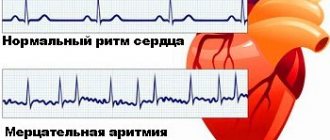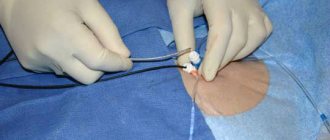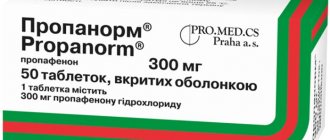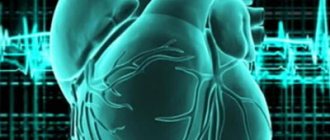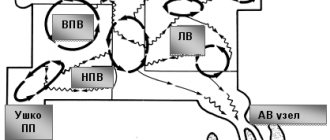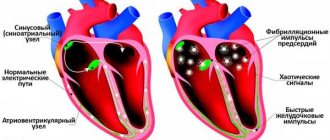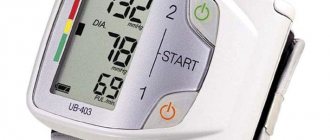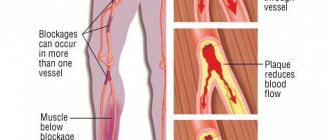Drugs for atrial fibrillation
Modern medications for atrial fibrillation are part of combination therapy along with special procedures, such as cardioversion. New antiarrhythmic drugs from various groups are used: anticoagulants, beta-blockers and others in the form of tablets, and injections are also prescribed. Atrial fibrillation is treated in a hospital setting or under the supervision of a cardiologist on an outpatient basis.
Potassium channel blockers
Drugs that act on potassium channels (phase 3, terminal repolarization) belong to the third class of antiarrhythmic drugs. They prolong the development of the action potential, slow down impulse conduction and reduce the excitability of myocardial cells.
Amiodarone
The use of Amiodarone in interrupting atrial fibrillation is effective. Treatment is carried out in a hospital setting or under constant supervision by a cardiologist in severe cases of atrial fibrillation. The drug simultaneously has the effect of inhibiting alpha and beta adrenergic receptors.
Available in the form of tablets of 0.2 g. For the first 10-14 days of treatment, an initial dose of 3-4 tablets is prescribed, taken in several doses and before meals. Maintenance daily dosage - 0.5 - 4 tablets.
Cordaron
The use of Cordarone for atrial fibrillation is similar to Amiodarone - they have the same active ingredient. But the first remedy is more expensive. If you need to replace Cordarone with atrial fibrillation, then Amiodarone, Opacordene, Sedacorone can be prescribed. But in severe cases of AF, many doctors do not recommend such a replacement due to dosage errors.
Sotalex
The main substance of Sotalex is a sotalol derivative that has a blocking effect on potassium channels, alpha and beta adrenergic receptors.
In the first stages of treatment for atrial fibrillation, 0.16 g (1 tablet) is prescribed, divided into 2 doses. The dosage can be increased to 0.32 g, less often - to 0.64 g.
The effectiveness of drug therapy
The treatment methods used effectively affect the patient’s condition and return it to normal, but do not eliminate the causes of the attacks. There are 2 main directions:
- Restoration of sinus rhythm. It is advisable to use this method to treat rare manifestations of arrhythmia, in the absence of pathological changes in the myocardium and the standard size of the heart chambers.
- Compensation for arrhythmic work of the atria by controlling the contraction of the ventricles. The technique is used to correct the rhythm to a normosystolic form. Used for regular attacks of arrhythmia, secondary changes in the heart muscle and enlarged atria.
Drug treatment for diseases of the cardiovascular system, in particular, myocardial infarction, can only be prescribed by a doctor. Self-treatment of atrial fibrillation can harm your health and even lead to death.
General therapy
Treatment goals for atrial fibrillation:
- reduction in the severity of symptoms;
- prevention of complications caused by thrombosis;
- treatment of concomitant heart diseases;
- heart rate control;
- restoration of normal rhythm.
Antiarrhythmic drugs
Long-term treatment for permanent atrial fibrillation depends on your heart rate. If the heart rate is too high, the course of the disease worsens and the frequency of complications increases. Therefore, the following medications are used to slow down the heart rate:
- beta blockers (bisoprolol, atenolol, carvedilol, metoprolol, esmolol, sometimes propranolol);
- non-dihydropyridine calcium channel antagonists (verapamil, diltiazem);
- cardiac glycosides (digoxin);
- amiodarone.
In this case, it is desirable to achieve a slowdown of the rhythm of less than 110 per minute.
If it is possible to restore sinus rhythm so that atrial fibrillation does not occur again, treatment includes tablets for the prevention of paroxysms:
- amiodarone;
- disopyramide;
- etacizin;
- dronedarone;
- allapinin;
- etmozin;
- propafenone;
- sotalol;
- flecainide.
The effectiveness of such treatment is not always high. In this case, the most effective drug is selected. This process may take a long time.
These drugs (except amiodarone) should not be used for persistent atrial fibrillation. They are used only against the background of sinus rhythm. The main criterion for choosing a drug for the treatment of paroxysmal atrial fibrillation is the safety of the drug, and not its supposed effectiveness.
The choice of remedy is carried out only by a doctor, taking into account many criteria:
- patient's age;
- Heart rate;
- concomitant heart diseases and circulatory failure;
- indicators of the blood coagulation system and many others.
Drug treatment of atrial fibrillation should be prescribed in accordance with modern National Cardiology Guidelines.
We recommend reading about the forms of atrial fibrillation. You will learn about what atrial fibrillation is, risk factors for its occurrence, and classification of AF. And here is more information about the causes and symptoms of atrial fibrillation.
Therapy for chronic (persistent) form
At the initial stage of treatment, all patients with atrial fibrillation are prescribed antithrombotic agents and agents to reduce heart rate. It is recommended to achieve a reduction in heart rate of less than 110 per minute at rest. This is controlled using a cardiogram and daily Holter ECG monitoring.
Means to slow heart rate are selected individually. The dosage should be such that bradycardia does not occur (heart rate slowing less than 40 - 50 per minute).
If atrial fibrillation occurs in a patient with WPW syndrome, the preferred drugs are amiodarone or propafenone. Digoxin is used only in persons with tachysystolic atrial fibrillation and concomitant heart failure. It is not recommended to prescribe it in paroxysmal form.
Algorithm for selecting rhythm-slowing therapy depending on the initial parameters of atrial fibrillation
The effectiveness of treatment is assessed by the patient’s well-being. His shortness of breath, weakness, dizziness and palpitations should decrease.
If the patient leads a sedentary lifestyle, digoxin is suitable for long-term treatment. With an active life and a young age of the patient, treatment is determined by concomitant diseases. For a healthy heart or hypertension, beta blockers or calcium antagonists are indicated. In the presence of obstructive pulmonary disease, bisoprolol, calcium antagonists or digoxin are prescribed.
In case of concomitant heart failure, beta blockers or diltiazem are preferred.
Treatment of persistent atrial fibrillation should be supplemented with drugs that reduce thrombus formation.
To learn how to treat atrial fibrillation in patients with chronic coronary heart disease, watch this video:
Antithrombotic therapy
Thromboembolic complications are the main danger of atrial fibrillation. Therefore, antithrombotic drugs are prescribed for atrial fibrillation. Their choice and dosage selection is very complicated and can only be done by a doctor. Treatment is carried out for both persistent and recurrent atrial fibrillation.
Basic means for the prevention of thrombosis:
- vitamin K antagonists (warfarin) under INR control;
- direct thrombin inhibitors (dabigatran);
- factor Xa inhibitors (rivaroxaban or apixaban).
Antithrombotic therapy is not prescribed to people with a low risk of thrombosis, for example, women under 65 years of age without concomitant aggravating factors. Taking acetylsalicylic acid (aspirin) alone is not recommended. If the patient refuses to take the latest generation of antithrombotic drugs, he can be prescribed a combination of aspirin and clopidogrel.
Antithrombotic therapy in patients with AF (ESC, 2012 and Recommendations of the RKO, BNOA and ACC, 2012)
If a patient has a mechanical heart valve, the only antithrombotic drug suitable for him is warfarin.
During treatment, anticoagulant therapy tactics should be monitored and revised if necessary. Therefore, patients with atrial fibrillation should be regularly monitored by a cardiologist. The convenience of the latest generation of drugs (dabigatran, rivaroxaban, apixaban) is that while taking them there is no need to constantly monitor blood counts.
When atrial fibrillation and coronary artery disease are combined, for example, angina pectoris or myocardial infarction, treatment tactics change, in this case aspirin is added. During cardioversion (electrical restoration of sinus rhythm), heparin administration is indicated for some time.
Let us once again emphasize the complexity of prescribing antithrombotic therapy for atrial fibrillation. Before any surgical intervention, you must visit a cardiologist and get his recommendations on changing treatment.
The “pill in your pocket” strategy
In some patients with attacks of atrial fibrillation from 1 time per month to 1
once a year, but accompanied by severe symptoms (shortness of breath, dizziness, chest pain), the “pill in your pocket” strategy can be used.
It involves the patient self-administering propafenone (propanorm) in tablet form when an attack occurs. The dosage is 450 - 600 mg. Before prescribing such treatment, it is necessary to evaluate the indications, contraindications and safety of the drug in a given patient, as well as train him in the correct use of the drug.
Drugs
Anticoagulants
Medications that slow down blood aggregation and blood clot formation are often prescribed for life. Warfarin for atrial fibrillation is used to treat a permanent form of the disease or for regular attacks. The medicine not only prevents thrombosis, it resolves already formed clots. As a preventive measure, it replaces an injection with Heparin. The disadvantages of Warfarin include an increased risk of bleeding. The drug requires monitoring of blood clotting. Another effective drug is Eliquis. This is a direct-acting anticoagulant based on apixaban. A modern remedy that significantly reduces the likelihood of stroke in atrial fibrillation. Requires monitoring of blood clotting. Do not use by pregnant or lactating women, children under 18 years of age, or with severe liver dysfunction.
Cardiac glycosides
Preparations based on raw materials of natural and synthetic origin, aimed at maintaining cardiac activity. List of medications:
- "Cardiovalent." The drug is based on natural extracts, sodium bromide and camphor. Sold in the form of alcohol drops. Has a sedative effect. The dose is 15 drops before meals.
- "Digoxin". Tablets with the same active ingredient. They have an inotropic and vasodilator effect with a moderate diuretic effect. You need to take Digoxin 4-5 times on the first day and 1-3 times thereafter.
Return to contents
Potassium channel blockers
They belong to the 3rd class of antiarrhythmic drugs, they reduce myocardial excitability due to the deterioration of impulse conduction. The drug "Amiodarone" normalizes heart function with virtually unchanged cardiac output, improves coronary blood flow, slows the heartbeat and lowers blood pressure. It is used during severe atrial fibrillation, for the first two weeks you need to take 3-4 tablets, then from half to 4 tablets as maintenance.
Sodium channel blockers
Medicines that have membrane-stabilizing and antiarrhythmic effects. They are divided into 3 groups: A, B and C according to the strength of impact. Among this group, Propanorm is effective. This is an antiarrhythmic drug used for disorders of supra- and ventricular rhythm. Slows down the conduction of impulses along specific fibers and has a slight adrenergic blocking effect. Contraindicated for people with heart failure, not recommended for pregnant women, prohibited during lactation.
Metabolic drugs
A large, heterogeneous group of drugs that alter metabolism in various variations. These medications include Panangin, a drug based on potassium and magnesium aspartates that saturates cells with ions of active substances. It is used to treat arrhythmias mainly caused by electrolyte disturbances and atrial fibrillation. Contraindicated in chronic and acute renal failure and hyperkalemia.
Slow calcium channel blockers
They inhibit the penetration of calcium ions into the heart muscles and blood vessels through specific channels. As a result, the coronary and peripheral arteries expand, that is, vasodilation. These include "Verapamil", which has a pronounced antianginal and antiarrhythmic effect, lowers pressure in the arteries. It has a large number of contraindications for concomitant diseases of the cardiovascular system.
Other drugs
In addition, drugs of various effects are used in therapy:
- "Bisoprolol." Selective beta-blocker, has a hypotensive and antianginal effect, reduces the electrical conductivity of the heart.
- "Anaprilin." A non-selective β-blocker, during an attack of arrhythmia, reduces the strength and frequency of the heartbeat, lowers blood pressure, and improves the tone of the bronchial muscle.
- "Cardiomagnyl". Prevents primary and repeated thrombus formation. Contraindicated for renal and liver failure, exacerbation of ulcers, pregnant women in the 3rd trimester, etc.
Metoprolol, a beta-blocker that has antianginal, hypotensive and antiarrhythmic effects, is also effective. Reduces heart rate, reduces excitability and contractility of the myocardium. Prohibited for pregnant and nursing mothers, with various heart diseases. Should be used carefully in diabetes mellitus, with impaired blood circulation and kidney function. Take 50 mg tablets 3 times a day.
Beta blockers
Substances that block beta-adrenergic receptors slow the contraction of the heart muscle without reducing cardiac output. Such drugs belong to class II antiarrhythmic drugs. But AF is not the only cardiovascular pathology for which beta blockers are used. They treat coronary heart disease, hypertension, etc.
Propranolol
Propranolol is sold in the form of tablets containing 0.01, 0.04 and 0.08 g of the main component.
The initial dose of this medicine is 0.02 g three times a day. Gradually the dosage is increased to 0.08-0.12 g, calculated for 2-3 doses. The maximum dose per day is 0.24 g of propranolol.
The use of the drug is not associated with food intake.
Other commercial names are Anaprilin and Obzidan.
Atenolol
Atenolol contains the active ingredient of the same name. The drug is available in the form of tablets with a dosage of 50 and 100 mg.
The minimum dose to relieve an attack is 0.05 g, but not more than 0.2 g. Maintenance treatment is achieved by taking 0.025 g per day before meals.
Betaxolol
Betaxolol is available in the form of tablets containing 20 mg of active ingredient. This drug is taken 1 tablet.
Bisoprolol
Bisoprolol contains bisoprolol fumarate. The medicine is produced in tablet form with 5 or 10 mg of the main component. The concentration is chosen depending on the patient's condition. Take 1 tablet once a day, regardless of food.
Metoprolol
Metoprolol tablets may contain 50 or 100 g of metoprolol tartrate. The maintenance dose is usually 50 mg 3 times a day.
Timolol
Timolol is a beta blocker popular in ophthalmology, used topically in the form of drops to treat glaucoma.
In cardiology, it is rarely used in tablet form, 10 mg 2 times a day.
What are anticoagulants
These are representatives of a separate pharmacological group, produced in the form of tablets and injections, which are intended to reduce blood viscosity, prevent thrombosis, prevent stroke, and in the complex therapy of myocardial infarction. Such medications not only productively reduce the coagulation of the systemic bloodstream, but also maintain the elasticity of the vascular walls. With increased platelet activity, anticoagulants block the formation of fibrin, which is relevant for the successful treatment of thrombosis.
Anticoagulants
To prevent the formation of blood clots and the development of thromboembolism, which often happens with frequent attacks of atrial fibrillation, it is necessary to introduce anticoagulants into the course of treatment.
The most popular representative of the drug group is Warfarin. Its main task is to block the synthesis of vitamin K-dependent factors in the liver.
The initial and subsequent dosage of the medication is determined by the attending physician in accordance with the patient's condition.
Treatment with this drug is contraindicated in patients with thrombocytopenia, severe liver disease, kidney pathologies and acute bleeding.
Cost – 55 rubles.
Indications for use
Anticoagulants are used not only for the successful prevention of thromboembolism; such a prescription is suitable for increased thrombin activity and the potential threat of the formation of blood clots in the vascular walls that are dangerous to the systemic blood flow. The platelet concentration gradually decreases, the blood acquires an acceptable flow rate, and the disease recedes. The list of drugs approved for use is extensive, and they are prescribed by specialists for:
- atherosclerosis;
- liver diseases;
- vein thrombosis;
- vascular diseases;
- thrombosis of the inferior vena cava;
- thromboembolism;
- blood clots of hemorrhoidal veins;
- phlebitis;
- injuries of various etiologies;
- varicose veins
Potassium and magnesium supplements
This type of medicine contains magnesium and potassium, which are necessary to maintain proper functioning of the heart muscle. They must be taken in conjunction with other medications that suppress the symptoms of atrial fibrillation. This group of drugs includes Asparkam, Panangin, Magnerot, Magne B6, etc.
Even if the patient is confident in the correctness of his diagnosis, he should under no circumstances self-prescribe medications. This task should be entrusted to a competent specialist.
Classification
The benefits of natural anticoagulants, which are synthesized by the body and prevail in sufficient concentration to control blood viscosity, are obvious. However, natural coagulation inhibitors can be susceptible to a number of pathological processes, so there is a need to introduce synthetic anticoagulants into the complex treatment regimen. Before determining the list of medications, the patient needs to consult a doctor to rule out potential health complications.
Direct anticoagulants
The list of such drugs is designed to suppress thrombin activity, reduce fibrin synthesis, and normal liver function. These are local heparins for subcutaneous or intravenous administration, necessary for the treatment of varicose veins of the lower extremities. The active components are productively absorbed into the systemic bloodstream, act throughout the day, and are more effective when administered subcutaneously than when administered orally. Among low-molecular-weight heparins, doctors identify the following list of drugs intended for administering heparins topically, intravenously or orally:
- Fraxiparine;
- Lyoton-gel;
- Clexane;
- Heparin ointment;
- Fragmin;
- Hepatrombin;
- Sodium hydrogen citrate (heparin is administered intravenously);
- Klivarin.
Indirect anticoagulants
These are long-acting drugs that act directly on blood clotting. Indirect anticoagulants promote the formation of prothrombin in the liver and contain vitamins valuable for the body in their chemical composition. For example, Warfarin is prescribed for atrial fibrillation and artificial heart valves, while the recommended doses of Aspirin are less effective in practice. The list of drugs is represented by the following classification of the coumarin series:
- monocoumarins: Warfarin, Sinkumar, Mrakumar;
- indandiones: Phenilin, Omefin, Dipaxin;
- Dicoumarins: Dicoumarin, Tromexane.
To quickly normalize blood clotting and prevent vascular thrombosis after a myocardial infarction or stroke, doctors strongly recommend oral anticoagulants containing vitamin K in their chemical composition. These types of medications are also prescribed for other pathologies of the cardiovascular system that are prone to chronicity and relapses. In the absence of extensive kidney disease, the following list of oral anticoagulants should be highlighted:
NOAC anticoagulants
This is a new generation of oral and parenteral anticoagulants, which are being developed by modern scientists. Among the advantages of this prescription are a quick effect, complete safety with respect to the risk of bleeding, and reversible inhibition of thrombin. However, there are also disadvantages of such oral anticoagulants, and here is a list of them: bleeding into the gastrointestinal tract, the presence of side effects and contraindications. In addition, to ensure a long-term therapeutic effect, thrombin inhibitors must be taken for a long time, without violating the recommended daily doses.
The drugs are universal, but the effect in the affected body is more selective, is temporary, and requires long-term use. In order to normalize blood clotting without serious complications, it is recommended to take one of the stated list of new generation oral anticoagulants:
Treatment with new oral anticoagulants
If previously it was believed that atrial fibrillation could be cured only with vitamin K antagonists, i.e., anticoagulants that thin the blood, now they have been replaced by a new generation of oral anticoagulants.
Older drugs reduce the risk of stroke, suppress vascular complications, and even the mortality rate drops thanks to them, but no matter how effective they are, there is always the possibility of bleeding, a hemorrhagic stroke can occur, and in its destructive power it is much worse than an ischemic one.
This is why it is necessary to monitor the quality of blood, and in this case, treatment requires adjustment of drugs if suddenly the state of the hemostatic system goes beyond the established range.
Successful treatment with vitamin K antagonists also depends on the fact what percentage of this vitamin enters the patient’s body through food. If the diet does not contain enough of this vitamin, then it is necessary to change it, and your doctor will tell you how to do this.
Those patients who are at risk of cardioembolic stroke have the opportunity to take direct thrombin inhibitors. They belong to a new generation of oral anticoagulants. Their most important properties are to block the effects of thrombin, which is the main protein involved in the process of blood clotting.
The newest class of drugs, compared to vitamin K antagonists, has nothing to do with food, and therefore no longer requires the patient to endlessly donate blood to check the condition. The risk of life-threatening bleeding is now significantly reduced. And new medications can be used if there are contraindications to taking vitamin K antagonists or there are some difficulties in monitoring their intake.
For atrial fibrillation, new anticoagulants must be taken for life. But it can be treated with these drugs only as prescribed by a doctor. Even the best remedies can only be selected by a doctor, since he knows much more about atrial fibrillation and takes into account whether there are any contraindications.
Read also: Arrhythmia in pregnant women
In addition, ignorant patients do not even realize that there are medications that provoke heart rhythm disturbances, that is, they have proarrhythmic activity. If an attack unexpectedly begins, the patient has the opportunity to stop this process on his own by using a drug prescribed by a doctor, without ending up in a hospital bed.
Such drugs include propaferon, or propanorm. It was approved by the European and American communities of cardiology. To purchase the medicine, you will need a prescription, and when prescribing it, the doctor calculates the patient’s body weight. This medicine stops the next attack and prevents its occurrence again. But you need to take it exactly at the same time.
Price for anticoagulants
If it is necessary to reduce blood clotting as soon as possible, doctors strictly for medical reasons recommend taking anticoagulants - the list of drugs is extensive. The final choice depends on the pharmacological characteristics of a particular medicine, the cost in pharmacies. Prices vary, but you need to pay more attention to the therapeutic effect. Below you can learn more about the prices in Moscow, but do not forget the main criteria for such a purchase. So:
Name of anticoagulant - from the list of drugs
Benefits of treatment
Changes in the blood coagulation system during atrial fibrillation occur under the influence of three main factors:
- stagnation, which forms in the vascular bed due to insufficient atrial systole or its complete absence;
- inability of the vascular endothelium to fully perform its anticoagulant function;
- excessive adhesion of platelet masses.
Although anticoagulant therapy reduces the risk of thrombosis, its use is still not widespread. This happens mainly due to the fact that different schools recommend different treatment regimens in this area, and some kind of uniform regimen for all has not yet been developed.
Another reason why anticoagulant therapy is not widely used for atrial fibrillation is the lack of data regarding the pathology that has developed against the background of mitral heart defects. Namely, it is because of mitral defects that a significant proportion of cases of arrhythmia develop, such as atrial fibrillation.
Read also: Sinus arrhythmia in athletes
It is now generally accepted that existing treatment regimens can be used for mitral stenosis, but such therapy has not been developed for mitral valve insufficiency, in which thromboembolism develops much less frequently and therefore does not require such extensive prophylaxis.
In patients with mitral stenosis, as well as in patients with AF, which is of non-valvular origin, anticoagulant therapy is clearly indicated and its effectiveness in these cases has been proven by many randomized studies.
Recommendations for anticoagulant therapy for atrial fibrillation for a practicing physician come down to the following main points:
- before choosing therapy, it is necessary to determine the risk groups for thromboembolic and hemorrhagic complications;
- it is necessary to establish whether there is an alternative to drug therapy and what is the feasibility of its use;
- it is necessary to assess the presence of contraindications for taking anticoagulant drugs;
- it is necessary to understand whether the doctor can monitor the patient’s coagulogram on a regular basis.
A description of the persistent form of atrial fibrillation can be found here.
Reviews
Marina, 29 years old I have had blood clotting disorders since childhood. I didn’t know anything particularly about anticoagulants as a pharmacological group. The doctor advised me to take an Aspirin tablet every morning. So I have been continuing this procedure for several years. Since there are no health problems, I think this medicine works. Cheap and cheerful.
Alexandra, 37 years old From the list I chose the medical drug Rivaroxaban. The medicine is new, but effective - it provides effective prevention of thrombosis. In our family, this disease is inherited through the female line, so I worried in advance about publicly available preventive measures. The drug is inexpensive, no complaints.
Victoria, 32 years old I have been diagnosed with varicose veins for several years now. The veins have not only become the cause of a strong inferiority complex, but also periodically hurt. The medical drug Lyoton gel from the list of direct anticoagulants helped me. The medicine works quickly and additionally relieves increased fatigue of the limbs after a working day.
Valentina, 41 years old From the list of drugs, I can praise Warfarin, which acts quickly and accurately on a health problem. A year ago, a doctor diagnosed me with a microstroke, and it was completely unexpected for me - apparently, I suffered it on my feet. This medicine was immediately prescribed for quick rehabilitation. The drug helped, no side effects occurred, although they were threatened.
Use of Warfarin
The international blood coagulation index, which they try to achieve in patients with non-valvular atrial fibrillation, varies between 2-3.
It is believed that if the indicator falls below 1.7, then the risk of developing thromboembolic complications increases significantly.
At the same time, a large group of doctors believes that if the indicator is above 3.5, there is no risk of developing hemorrhagic complications.
Contrary to this popular belief, studies have shown that if the international blood clotting level rises above 3.5, this leads to an increased risk of bleeding. An indicator below 4 is considered extremely dangerous.
Such scattered data from clinical and research practice lead to the fact that the maximum effective and safe dosages of Warfarin have not yet been established.
If it is necessary to temporarily stop Warfarin therapy in patients whose risk of developing thromboembolism is low, it is recommended to stop taking the drug for a period of a week. In this case, Heparin therapy may not be prescribed.
If the need to interrupt the use of Warfarin arises in a patient with a high risk of complications, then low molecular weight or unfractionated heparins are indicated. In this case, the period of interruption of the use of Warfarin may exceed a week.
Anticoagulants for atrial fibrillation. Mnemonics.
Choice of anticoagulant for atrial fibrillation.
Reading guidelines often works no worse than sleeping pills, and what’s interesting is that this effect persists no matter what language they are written in. But recently a small miracle happened: the American College of Cardiology and the American Heart Association jointly published guidelines for the management of patients with non-valvular atrial fibrillation. The main point of these recommendations is the use of anticoagulant therapy in such patients. This point is presented in the form of a mnemonic! The causes of Atrial Fibrillation will help you remember another mnemonic on Atrial Fibrillation in this article.
What is atrial fibrillation?
Otherwise, this disease is called atrial fibrillation. This happens because the atria begin to contract much more often than required, ahead of the ventricles.
And the reason is that the flow of irregular electrical impulses in the cardiac conduction system is restrained. Elderly people who have crossed the threshold of 70 years of age especially suffer from heart rhythm disturbances. But younger people, even 20-year-olds, can experience the full complexity of the disease, especially if they have various congenital defects of the cardiac system.
Alcoholics may also have a similar disorder due to their specific lifestyle.
Access to the requested page is denied
Possible reasons why this error occurred:
- Access is intentionally blocked by the site owner
Try to contact the site owner and negotiate with him to provide access to the materials you are interested in
What are anticoagulants and when are they used?
An anticoagulant is a medication that prevents the formation of blood clots. These include drugs such as warfarin and syncumar. Both of these drugs block the formation of vitamin K in the liver, without which the blood loses its ability to clot, of course to a certain extent. Anticoagulants are used in cases where the patient has a high risk of developing thromboembolic complications (see the article “What are the goals of treating atrial fibrillation”).
Taking this drug is the only protection against stroke, although not 100%. For the drug to work effectively, it is necessary to keep the blood “liquid” and here the patient and the doctor walk on a razor’s edge, you need to catch the “golden mean”, since if the amount of the drug taken is ineffective, it is ineffective protection against stroke, a waste of money and a burden on the excretory organs , and if taken in excess, there is a risk of bleeding.
Therefore, taking anticoagulants is troublesome, since constantly, first once every two weeks, and then once every 2-3 months, you need to take a certain blood test for INR or PTI, which shows the state of your coagulation system.
Cardiac glycosides
The action of cardiac glycosides is aimed at slowing down heart contractions and increasing their efficiency. These drugs are often used in the treatment of various cardiac pathologies.
Digitoxin
This drug is obtained from foxglove.
In rare cases, in hospital treatment, high doses are first prescribed (0.6 mg 2 times a day), followed by transition to maintenance therapy (0.15 mg per day). More often, they first give 0.2 mg 2 times a day, moving to 0.3 mg/day.
In the treatment of atrial fibrillation, the drug is used in the form of tablets (0.1 mg).
Digoxin
Available in the form of tablets containing 0.25 mg of the main component.
In emergency cases, in the first 36 hours, take 3 to 5 tablets in 2 doses. After this, they switch to maintenance therapy (0.5-3 tablets).
Most often in the first week they take 0.5-2 tablets. Then preventive MA treatment is prescribed.
Cardiovalen
Contains a complex of herbal concentrates, extracts and tinctures, as well as camphor and sodium bromide. Represents alcohol drops. Has additional sedative properties.
To take, about 15 drops are diluted in water and drunk half an hour before meals.
Celanide
The tablet contains 0.25 mg of lanatocide C obtained from digitalis, drops for internal use - 0.05% of this substance.
The dosage is selected individually. More often, to achieve a therapeutic effect, up to 25 drops 3-4 times or up to 1-2 tablets per day for 5 days are prescribed. Subsequently, the dose is reduced. When used orally, the daily dose should not exceed 1 g.
Anticoagulants for atrial fibrillation. Mnemonics.
Choice of anticoagulant for atrial fibrillation.
Reading guidelines often works no worse than sleeping pills, and what’s interesting is that this effect persists no matter what language they are written in. But recently a small miracle happened: the American College of Cardiology and the American Heart Association jointly published guidelines for the management of patients with non-valvular atrial fibrillation. The main point of these recommendations is the use of anticoagulant therapy in such patients. This point is presented in the form of a mnemonic! The causes of Atrial Fibrillation will help you remember another mnemonic on Atrial Fibrillation in this article.
How often do you have to decide whether or not to prescribe Coumarin or Aspirin to a patient, which is more dangerous for a given patient with atrial fibrillation - embolic stroke or bleeding caused by anticoagulants. Now the solution to this problem has become much simpler; it is enough to collect risk factors from the patient’s medical history and add up the points scored.
With this message we want to open a new section on the site: “Medical mnemonics.” There are a lot of them on the Internet, but alas, like today’s mnemonics, they are in English. Therefore, if you have your own developed mnemonics and want to share them with your colleagues, send them to the site or simply leave them in the comments to the articles. We will publish them along with the names of those who sent them (if you wish). How do you remember the names of the wrist bones or the functions of the cranial nerves, the classes of anti-arrhythmic drugs, or the causes of chest pain? Your colleagues, especially medical students, will be grateful to you for a good hint in the form of mnemonics!
Now let’s return to atrial fibrillation and the prescription of anticoagulants for this disease. The CHADS2 mnemonic is composed of risk factors for embolic stroke in the following patients:
- Cardiac Failrue - Heart failure - 1 point
- Hypertenstion - Hypertension - 1 point
- Age 75 and above - Age 75 and older - 1 point
- Diabetes - Diabetes - 1 point
- Stroke (previous Stroke or TIA) - History of Ischemic Stroke or Transient cerebrovascular accident. microstroke - 2 points
Add up your patient's scores to get the recommended stroke prevention method. If the amount
0 - Aspirin from 80 to 325 mg per day;
1 - Aspirin or Coumarin (Warfarin), the choice of choice is individual
2 - or more - Coumarin (Warfarin)
You can find the full text of the article (in English) by clicking on the link (1) below.
Reference 2: General Guidelines for Antithrombosis and Thrombolytic Therapy from the American College of Chest Physicians
Prescribing anticoagulants for patients at high risk of Stroke who are not included in the above CHADS2 scale.
Extended mnemonic CHA2DS2VASc
includes the previous one, reduces the age at risk of stroke from 75 to 65 years and adds new categories of patients for whom anticoatulant therapy is indicated.
Treatment of atrial fibrillation (outpatient)
The term “atrial fibrillation” was introduced into the clinic by G.F. Lang, meaning atrial fibrillation and atrial flutter. Atrial fibrillation is a complete disorganization of the rhythmic activity of the atria when atrial systole is absent.
We also discuss the topic of atrial fibrillation in detail in our advanced training courses in cardiology.
The prevalence of atrial fibrillation increases with age: • In the general population: up to 2% • Over 20 years: 2% • Over 60 years: 5% • Over 75 years: 10% • In cardiology departments: 25% • Among patients with arrhythmias: 35 % But these data are not reliable, since in 45% of patients atrial fibrillation (AF) was detected completely by chance!
What are the causes of temporary transient atrial fibrillation? (can only occur once in a lifetime and usually in acute situations):
• Alcohol intoxication • Electrical trauma • Acute myocardial infarction • Acute myocarditis • Acute pericarditis • Pulmonary embolism • Acute bronchopulmonary diseases • Surgical heart injury
In this case, we are interested in chronic atrial fibrillation and the causes of its occurrence:
- Arterial hypertension (AH)
- Chronic heart failure (CHF), II-IV functional class
- Heart defects
- Idiopathic atrial fibrillation
- Myocardial dystrophy
- Coronary heart disease (CHD)
- Obesity
- Diabetes mellitus (DM)
- Chronic obstructive pulmonary disease (COPD)
- Chronic kidney disease (CKD)
- Athletic heart (athletes are much more likely to experience atrial fibrillation than the general patient population).
Periods of atrial fibrillation are very important ! • 48 hours: if atrial fibrillation (AF) continues for 48 hours, the risk of stroke sharply increases after restoration of sinus rhythm: about 2% (1-5.3%); This is due to the fact that blood clots can form during atrial flutter. If MA lasts for more than 48 hours, restoration of sinus rhythm cannot be started without anticoagulant preparation (otherwise, thromboembolic complications may occur 3-4 days after restoration of sinus rhythm: ischemic stroke, thromboembolism of the abdominal organs or extremities). • 7 days: if MA is maintained for 7 days, the likelihood of spontaneous restoration of sinus rhythm is markedly reduced. If paroxysm occurs, it is necessary to immediately begin restoring sinus rhythm (if there are no contraindications for this).
Classification of atrial fibrillation (AF) and atrial fibrillation:
– First-time - paroxysmal or persistent form of AF: 24-48 hours (in this case, it is better to indicate in the diagnosis not the first-time occurrence, but the first-time diagnosed form, since it is impossible to say with certainty whether it appeared for the first time or the patient simply had not previously sought the help of doctors): • for the first time; • paroxysmal: a period of up to 7 days (inclusive), up to 60-70% of cases, sinus rhythm is restored spontaneously within the first 24-48 hours (but it is worth noting that the paroxysmal form is often tachysystolic, in which spontaneous restoration of sinus rhythm is extremely rare, therefore, with this course of AF, a reduction in the number of ventricular contractions is necessary); • persistent (intermittent): more than 48 hours, but less than 7 days (differs from the paroxysmal form of AF in that a decrease in the number of ventricular contractions does not lead to independent restoration of sinus rhythm; drugs that stop AF are needed); • longstanding persistent AF: more than 1 year (restoration of sinus rhythm is possible). But there are cases when restoring sinus rhythm is not advisable: the active phase of rheumatism, heart disease requiring surgical intervention, a history of thromboembolic complications, large sizes of the left atrium (more than 5.5 cm). • permanent (chronic) form: more than 7 days (sinus rhythm (SR) is not restored): a decision is made not to restore SR, since it either will not recover at all or will recover for a very short period of time; or at the moment, restoration of SR is contraindicated (this requires the use of anticoagulants, and in a patient with high levels of arterial hypertension, their use is dangerous. In such a situation, it is necessary to first compensate for arterial hypertension, reduce blood pressure values, make them more stable, and only then begin restoration sinus rhythm).
There is also a classification of the severity of AF:
- No symptoms;
- Mild symptoms, normal daily activities are not affected;
- Severe symptoms, normal daily activities are impaired;
- Disabling symptoms, normal daily activities are impossible.
If a patient with atrial fibrillation comes to you for the first time, it is imperative to send him to the hospital for examination and identification of the cause of AF and the issue of the need to restore sinus rhythm)!
Indications for restoring sinus rhythm in the prehospital stage include:
- AF duration 48 hours in combination with:
• severe shortness of breath and moist rales in the lungs; • arterial hypotension 150 per 1 min
In this case, at the prehospital stage it is necessary not to restore sinus rhythm, but to reduce the heart rate!
- In an acute situation (mandatory in the absence of Wolff-Parkinson-White syndrome (WPW syndrome), intravenous beta-blockers (BABs) or verapamil are necessary to slow the ventricular rate, but caution must be exercised in patients with hypotension and heart failure (I, A) ;
- To control heart rate in an acute situation in patients with AF and HF or arterial hypotension, intravenous administration of cardiac glycosides or amiodarone (I, B);
- In patients with WPW syndrome, the drugs of choice are propafenone or amiodarone (I, C);
- In the presence of WPW syndrome and AF, beta blockers, verapamil, digoxin and adenosine (ATP) are contraindicated (III, C).
What medications can be used in the prehospital stage? Class IIA – Quinidine, Novocainamide, Disopyramide IB – Lidocaine, Mexiletine IC – Ethacysine, Propafenone It should be noted that propafenone is especially indicated against the background of tachycardia, and Ethacysine and allapinine are indicated for normosystole or a tendency to bradycardia. Allapinin, Ethmosin and Gilurythmal are difficult to classify into a specific subclass of class I Class II - Beta blockers Class III - Amiodarone, Sotalol Class IV - Verapamil, Diltiazem For cardiac arrhythmias, class 1c antiarrhythmic drugs (AAP) are recommended for patients without significant organic changes in the heart. What are pronounced organic changes in the heart? • Chronic heart failure stage III, FC IV, left ventricular (LV) ejection fraction less than 40%; • Acute forms of coronary artery disease, previous myocardial infarction (especially the first six months); • Left ventricular hypertrophy (LVH) more than 1.4 cm. Arterial hypertension, chronic forms of coronary artery disease, heart defects, etc. are not a contraindication to the use of class 1c AAP (in particular propafenone).
Propafenone (drug propanorm ) is used for a wide range of arrhythmias:
• Antiarrhythmic therapy before and after radiofrequency ablation (RFA) • Supraventricular and ventricular extrasystoles • Atrial fibrillation • All variants of paroxysmal supraventricular arrhythmias, including WPW syndrome • Arrhythmias in pregnant women • Arrhythmias in athletes The “efficacy-safety” ratio of propanorm is the best among antiarrhythmics!
As for the drug Sotalol , the antiarrhythmic effect occurs only after taking ≥ 160 mg! Treatment should be started in a hospital with a dose of 40 mg 2 times a day. The highest dose is 160 mg; in extreme cases - 320 mg).
Side effects include: – Adverse effects on the kidneys, risk of cumulation – Prolongation of the QT interval (which often leads to torsades de pointes; up to 10% ventricular fibrillation; almost 100% sudden death) Therefore, sotalol must be used with extreme caution!
The same applies to allapinin .
The effectiveness of the drug is 27%, while the probability of developing ventricular tachycardia by the 3rd year of use is 50%, and mortality is 27%!
Source: //medpodgotovka.ru/blog/about_ma
Access to the requested page is denied
Possible reasons why this error occurred:
- Access is intentionally blocked by the site owner
Try to contact the site owner and negotiate with him to provide access to the materials you are interested in
What are anticoagulants and when are they used?
An anticoagulant is a medication that prevents the formation of blood clots. These include drugs such as warfarin and syncumar. Both of these drugs block the formation of vitamin K in the liver, without which the blood loses its ability to clot, of course to a certain extent. Anticoagulants are used in cases where the patient has a high risk of developing thromboembolic complications (see the article “What are the goals of treating atrial fibrillation”).
Taking this drug is the only protection against stroke, although not 100%. For the drug to work effectively, it is necessary to keep the blood “liquid” and here the patient and the doctor walk on a razor’s edge, you need to catch the “golden mean”, since if the amount of the drug taken is ineffective, it is ineffective protection against stroke, a waste of money and a burden on the excretory organs , and if taken in excess, there is a risk of bleeding.
Therefore, taking anticoagulants is troublesome, since constantly, first once every two weeks, and then once every 2-3 months, you need to take a certain blood test for INR or PTI, which shows the state of your coagulation system.
If you are not going to seriously deal with this issue, then it is better not to even start taking anticoagulants, but to drink aspirin, but do not expect that it will reliably protect you from a stroke; in this regard, it is an order of magnitude inferior to warfarin.
Conservative treatment
An experienced cardiologist who thoroughly knows the indications and contraindications of drugs should select drug therapy for AF. We should not forget that many antiarrhythmics have difficult interactions with other medications. Also, some of them have so-called proarrhythmic activity - this means that uncontrolled use of drugs can itself cause an episode of arrhythmia. The drug treatment strategy is carried out, as a rule, in three directions:
Medicines that normalize rhythm.
The drugs of choice in these cases are propafenone (Propanorm), amiodarone (Cordarone), and sotalol. Antiarrhythmics for stopping an attack are best used in a hospital if cardiac monitoring and clinical observation are possible.
Drugs to control heart rate
. If sinus rhythm cannot be restored or attacks of atrial tachyarrhythmia constantly recur, the doctor’s tactic is to reduce the rate of ventricular contraction to a normal frequency, thereby “saving” the heart and normalizing its pumping function. To convert arrhythmia to a normal form (slow down the rhythm to a heart rate of 60–70 beats/min), drugs of the beta-blocker group, calcium antagonists of the verapamil group (non-dihydropyridines), sometimes digitalis drugs (glycosides), as well as drugs that reduce heart rate without recovery are used rhythm. The selection of therapy is usually carried out in the hospital, then the patient takes medications according to the developed regimen for a long time.
Antithrombotic therapy
. One of the most serious complications of AF is vascular accidents (stroke, myocardial infarction and other organs) due to the formation of blood clots in the atria. To prevent thromboembolic conditions in chronic AF, treatment with blood thinning medications is necessary. These include the indirect anticoagulant warfarin and the so-called “new” anticoagulants (Prodaxa, Xarelto), which are involved in a complex coagulation mechanism.
Anticoagulants list of drugs for arrhythmia
Anticoagulant drugs inhibit the activity of the blood coagulation system, preventing the formation of new blood clots or destroying existing ones. This group of drugs has become widespread in all branches of medicine.
Thanks to such drugs, mortality in surgical patients has significantly decreased in the postoperative period.
What it is?
Anticoagulants are substances or drugs that suppress the activity of the blood coagulation system and also prevent the formation of blood clots .
Drugs of this series are used in all areas of medicine . However, anticoagulants are most widely used in cardiology and surgery. During any, even minor, surgical interventions, the integrity of body tissues is compromised. In this case, the hemostatic system is activated, which is characterized by increased thrombus formation.
Failure to correct this condition can lead to the development of acute disorders of cerebral and coronary circulation, as well as thromboembolism of the branches of the pulmonary artery.
That is why it is extremely important to carry out adequate anticoagulant therapy in the postoperative period .
In cardiological practice, the use of anticoagulants becomes especially important in the post-infarction period, with arrhythmias, as well as heart failure.
Anticoagulants are prescribed for life to patients who have undergone stenting or coronary artery bypass grafting.
Natural anticoagulants
You can understand what anticoagulants are only by understanding the mechanism of action of these substances. In the human body there are both coagulation and anticoagulation systems.
The former are responsible for the formation of thrombotic masses when the integrity of vascular structures is violated .
The latter prevent excessive activity of the blood coagulation system, and are also responsible for the timely breakdown of existing blood clots.
Natural anticoagulants are divided into primary and secondary. Primary factors constantly circulate in the vascular bed and prevent the uncontrolled formation of blood clots. They are also divided into several subcategories.
- Fibrin creation inhibitors – prevent the conversion of fibrinogen to fibrin.
- Antithromboplastic substances have an antiprotrobinase effect.
- Antithrombins are structures that bind thrombin.
A decrease in the activity of these substances causes the development of thrombosis, and is also one of the key factors in the appearance of DIC syndrome.
Injections to thin the blood
Injectable medications can be used to thin the blood.
Aktilise
The therapeutic effect of Actilyse is explained by alteplase, which promotes the conversion of plasminogen into plasmin, as a result of which fibrin clots dissolve. The drug reduces the number of deaths after a heart attack from thromboembolism.
The medicine is recommended for pulmonary embolism with unstable hemodynamics and ischemic stroke.
The drug is contraindicated if you have the following health problems:
- intolerance to gentamicin and the composition of the injections;
- tendency to bleed;
- extensive blood loss in the last six months;
- history of central nervous system pathology;
- cerebral hemorrhage, recent head injury;
- decompressible arterial hypertension;
- severe liver pathologies;
- acute inflammation of the pancreas;
- inflammation of the heart of a bacterial nature;
- gastrointestinal ulcer within the last 3 months;
- tumors at high risk of bleeding;
- defects and aneurysms of blood vessels.
It should not be prescribed in combination with oral anticoagulants in children under 18 years of age if there has been major surgery or trauma in the last 3 months, cardiopulmonary resuscitation for more than 2 minutes, or recent puncture of blood vessels. It is contraindicated for women who have given birth in the last 10 days.
If the drug is prescribed for the treatment of acute myocardial infarction and pulmonary embolism, then it is not recommended for the following diseases:
- stroke;
- TIA within the last six months, except in cases of acute ischemic stroke within 4.5 hours.
The medicine should not be prescribed for acute ischemic stroke in the presence of the following pathologies:
- intracranial hemorrhage;
- the appearance of signs of ischemic stroke more than 4.5 hours before the start of intravenous infusion of Actilyse;
- mild stroke symptoms or rapid improvement in the patient’s well-being;
- severe stroke, convulsions at its onset;
- suffered a stroke or traumatic brain injury 3 months before treatment with Actilyse;
- previous stroke in patients with diabetes mellitus;
- thrombocytopenia;
- expressions arterial hypertension;
- severe increase or decrease in blood sugar.
Treatment with Actilyse may cause blood loss, which will lead to the death of the patient.
In addition, the following side effects may occur during therapy:
- allergy;
- bleeding in the eyes;
- nausea, vomiting;
- hypotension;
- increased body temperature;
- fat embolism;
- heart rhythm disturbance;
- need for transfusions.
Heparin
It prevents the formation of blood clots and affects platelet function.
Heparin should only be prescribed by a doctor, since it is contraindicated if there is a threat of miscarriage, and it should also not be prescribed if the following pathologies are present:
- intolerance to the composition of the drug;
- decreased platelet levels;
- poor blood clotting;
- severe dysfunction of the liver, kidneys, pancreas;
- pathologies that can cause internal bleeding, for example, gastrointestinal ulcer, high blood pressure, cerebral hemorrhage, aortic aneurysm, endocarditis of infectious origin.
Heparin should not be administered to the patient if a cerebrospinal fluid puncture is to be taken from him or if he is undergoing surgery using spinal or epidural anesthesia.
Treatment with Heparin may cause the following adverse reactions:
- thrombocytopenia;
- bleeding from the lungs, gastrointestinal tract, skin, genitourinary system;
- bleeding in the brain;
- allergy;
- narrowing of the lumen of blood vessels;
- aldosterone deficiency in the body, which causes metabolic acidosis and increased potassium levels in the blood;
- skin necrosis;
- hair loss;
- increased levels of liver enzymes in the blood;
- osteoporosis;
- prolonged and painful erection unrelated to sexual arousal;
- compactions, calcification, redness, bruising, depigmentation at the injection site.
Cibor
Cibor contains bemiparin sodium as an active ingredient. This is a direct anticoagulant, which belongs to low molecular weight heparins. It enhances the effect of antithrombin III.
It is recommended for the prevention of thromboembolism during surgical treatment, as well as in patients at high risk of blood clots. The drug is used to prevent blood clotting in the artificial kidney machine.
The medicine is contraindicated if you are intolerant to the composition of the drug, heparin or products made from pork. It is also prohibited in the same cases as Heparin. The course of therapy with Cibor should not exceed 3 months. It causes the same side effects as Heparin.
Fraxiparine
Fraxiparine contains nadroparin, which is an anticoagulant, as a medicinal component of calcium. It exhibits antithrombotic activity, and, unlike unfractionated heparin, it has less effect on platelet adhesion and function. If the drug is prescribed in prophylactic dosages, it does not significantly reduce ATHR.
Fraxiparine is used to treat non-Q wave myocardial infarction, thromboembolism, and unstable angina. It is also used to prevent blood clotting during hemodialysis and to prevent thromboembolism.
The anticoagulant is not recommended for children, as well as in the presence of the following pathologies:
- allergy to the composition of the injections;
- thrombocytopenia in the past caused by nadroparin;
- predisposition to bleeding;
- cerebral hemorrhage;
- septic endocarditis in the acute stage.
The drug should not be prescribed for the treatment of unstable angina, thromboembolism, or myocardial infarction without a Q wave in patients whose glomerular filtration rate is less than 30 ml per minute.
The following negative effects may occur due to treatment with Fraxiparine:
- decreased platelet count;
- increased number of eosinophils and potassium in the blood;
- allergy;
- strengthening the function of liver enzymes;
- hematoma at the injection site;
- skin necrosis at the injection site, if it occurs, the course of treatment must be urgently interrupted;
- priapism.
Anticoagulants: review of drugs, use, indications, alternatives
Mechanism of action
Electrical cardioversion is sometimes recommended in patients with persistent or paroxysmal atrial fibrillation. If the arrhythmia continues for more than 48 hours, you must first prevent the presence of blood clots in the heart by taking Warfarin or new oral anticoagulants (Pradaxa, Xarelto, or Eliquis) or check for the absence of blood clots by examining the atria with transesophageal echocardiography.
Then, after the use of sedatives and analgesics, when the patient has fallen asleep, using special equipment, a high-voltage discharge is applied to the chest area. Such a discharge “zeroes” the activity of pathological foci of electrical impulses in the heart and it gets the opportunity to restore rhythm from a natural source.
After cardioversion, it is necessary to take medications that reduce blood clotting to prevent blood clots.
The main alternative for relieving atrial fibrillation is the use of medications, both intravenously and in the form of tablets. However, the drugs are not always effective. In addition, during episodes of atrial fibrillation accompanied by severe manifestations of heart failure, the doctor does not have time to wait to see whether the medication used will have an effect or not.
Low-energy multistage electrotherapy (MSE) may soon become a method that will avoid the application of powerful shocks. When it is performed through an electrode inserted into the right atrium (this procedure is well established, does not present technical difficulties and is performed quickly), discharges with a power of several tenths of a joule are applied, painless for the patient.
Basic principles of treatment
The choice of treatment tactics for patients with paroxysms of atrial fibrillation depends on several factors, among which the key role is played by the course of the disease, the frequency of attacks and the degree of their complexity. Currently, the elimination of the symptoms of atrial fibrillation occurs through drug correction, and in rare cases, surgical intervention. Therefore, before treating atrial fibrillation, you should undergo the entire range of necessary studies that will help you understand the etiology of the disease and assess the possible risks of developing complications dangerous to normal life.
In their practice, cardiologists use two strategies for treating the disease:
In most cases, specialists are inclined to use the first method and stabilize the patient’s sinus rhythm, which is one of the most effective ways to prevent pathological blood clots.
What treatment can relieve me of atrial fibrillation (atrial fibrillation)?
In the vast majority of cases, this treatment can be catheter radiofrequency ablation. Radiofrequency ablation is most effective in patients with paroxysmal atrial fibrillation, with success rates achieved in approximately 88% of cases. In the case of persistent atrial fibrillation, the success of the procedure is less, but gradually increases with the introduction of new techniques into practice. In some cases, repeat ablation procedures may be necessary.
Like any intervention, ablation carries certain risks. The main one is stroke, so before the procedure a careful assessment of the likelihood of this complication is carried out.
Atrial fibrillation: treatment in older people
Irregular rhythm is a consequence of many etiological factors. If after 60, arrhythmia is associated with vascular damage by atherosclerosis, then in young and middle age hormonal changes come to the fore: intoxication with thyroid hormones, menopause.
Therefore, the treatment of atrial fibrillation in the elderly has its own characteristics. After 60 years, arrhythmia often becomes permanent. Treatment in this case comes down to monitoring the heart rate. Digoxin or cordarone is used for this purpose. The drugs are taken in an individual dose under pulse control.
Both digoxin and cordarone accumulate in the body and can cause symptoms of intoxication, which are manifested by nausea, vomiting, and changes in the cardiogram. Therefore, these medications should be taken under medical supervision, pulse monitoring and ECG monitoring. For heart failure, diuretics are added to therapy. Antihypertensive drugs are prescribed to correct blood pressure.
Before prescribing digoxin, an analysis of the level of potassium in the blood is done, since the drug removes this trace element from the body, causing the appearance of ventricular extrasystoles. Severe digitalis intoxication can develop into a dangerous rhythm disorder - ventricular fibrillation.
If beta blockers are used to treat atrial fibrillation in young people, digoxin is used in older people, as it reduces the frequency of contractions at rest and also has a diuretic effect. Provoking factors are often the following:
- Colds, ARVI; hypertonic disease;
- Cardiac ischemia, angina pectoris;
- Obesity;
- Physical and emotional stress;
- Hypokalemia.
The basic rules for treating atrial fibrillation in the elderly include constant use of medications under the supervision of a physician. A normal heart rate, even with arrhythmia, does not interfere with leading a normal, measured lifestyle.
Procedures and surgery for atrial fibrillation
Today, there are a number of treatment options for atrial fibrillation through special procedures and surgeries aimed at restoring normal heart rhythm. These include the following:
- Electrical cardioversion : While the patient is under anesthesia, the doctor applies a high-energy pulsed electrical discharge to the heart area to restore normal heart rhythm.
- Catheter ablation : If the cause of atrial fibrillation is one or more pockets of arrhythmia that cause fluttering (fibrillation) in the heart, you may consider catheter ablation. During this procedure, an electrophysiologist guides long, thin tubes (catheters) through the blood vessels to the heart. After the catheter has reached the source of the arrhythmia, the electrophysiologist destroys it with heat or cold. This procedure destroys cells that cause the heart to function abnormally.
- Pacemaker implantation : In some cases, especially with sick sinus syndrome (sinus node disease or sinus node dysfunction), doctors may recommend implanting a pacemaker to help keep the heart beating at a normal rhythm. A pacemaker is a small electronic device that is surgically implanted in the chest. It produces electrical impulses that stimulate the heart to beat at a normal pace.
- Atrioventricular (AV) node ablation : In AV node ablation, radiofrequency energy is applied between the upper chambers of the heart (atria) and the lower chambers of the heart (ventricles). Energy is directed to an area called the atrioventricular node to destroy a small amount of tissue that causes irregular impulses to the ventricles, causing atrial fibrillation. Typically, a small pacemaker is also implanted to help the heart maintain a normal rhythm.
- Maze surgery : If you are scheduled to have open heart surgery to treat a heart condition, such as a faulty heart valve or blocked arteries, the surgeon may also perform a surgical procedure called "maze" to treat AFib. The surgeon will make tiny incisions in the upper chambers of the heart. These incisions will heal, but scar tissue will remain in their place. Why do you need scar tissue in your heart? Because scar tissue does not conduct unorganized electrical impulses. In fact, this surgery disrupts the electrical impulses that cause the symptoms of atrial fibrillation.
Implantation of a pacemaker allows you to control your heart rhythm, preventing the symptoms of atrial fibrillation.

